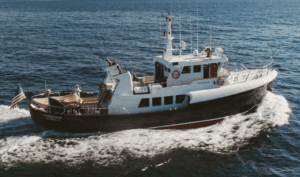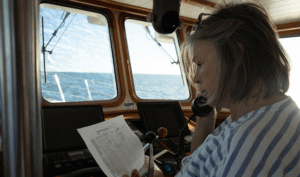

Christy Steinman-Crawford Donnelly herded a fleet of 30 recreational powerboats on a 1,000-nautical-mile voyage down to Mexico, as communications director for the 2019 Cruise Underway to Baja Rally (CUBAR), a bi-annual cruise from San Diego to La Paz, Baja for 30 to 50 powerboats. It was an odyssey that included one medical evacuation at sea.
Of course, that was not her first rodeo. Donnelly has navigated and sailed with the “best of the best.” She navigated the race boat Kialoa in Britain’s famous 1979 Fastnet Race; she navigated for Tom Blackhaller to win the 1980 Bermuda Race, and she was the first woman to crew for Dennis Conner in the America’s Cup for four years. She has also raced in the SORC and Admiral’s Cup.
“I’ve spent much of my life on the water,” she said. “Sailing and navigation have always been my passions.”

With such high-tech experience, how did you get roped into herding cats for the CUBAR?
“Well, since 2007 I had been helping San Diego Yacht Club’s amateur radio club perform our HF roll calls for offshore events like the Puerto Vallarta Race, the 2013 CUBAR and other racing and cruising events.” (Donnelly actively uses her ham radio general license KC6GIL.) “Since 2013 I had also been using a Garmin InReach – previously called Delorme. It’s a small satellite communicating device. While cruising the Sea of Cortez, I had enjoyed the Chubasco Net, the California Baja Net and the Pacific Maritime Net.”
When did you first participate underway in a CUBAR?
“In 2015 my husband Ken Donnelly and I piloted Varnebank, our 77-foot steel Dutch trawler. The first time we participated underway, as one of 50 other power boats. We had our SSB and ham capabilities, and I had suggested that the CUBAR committee might use SSB to stay in touch, but surprisingly few of these bigger powerboats either had them installed or knew how to use them. I did use my InReach a little bit during that CUBAR.
“That was the first time the CUBAR committee tried to keep all 50 vessels in touch with each other only via VHF and satphones. As you know, VHF’s not going to work unless you’re close together. And they really hadn’t tried out the satphone part. Boats trying to reach each other on their different satphones found out they were on different constellations, each with its own issues.
“That 2015 CUBAR had tremendous difficulty, because after Ensenada a front came through and the committee boat decided not to stop in Turtle Bay as planned but to proceed 240 nautical miles farther south to Bahia Santa Maria. Obviously with 50 vessels of all different sizes and speeds, the fleet became split up. Some of the boats did continue to Bahia Santa Maria, but many had trouble because it was just too rough and windy. They couldn’t proceed so had to put into Turtle Bay. Nobody knew where every boat was. Not good. And they couldn’t find the missing boats on VHF or sat phones.
“In order to help a bit, I was able to find the seven missing boats by using the California Baja ham net. Another ham radio operator happened to be a guest aboard one of our CUBAR vessels that had hunkered down in Turtle Bay. He notified me when the others limped in, and I notified the committee boat. I used my InReach to send text messages at that time.
“After that 2015 CUBAR, I reported back to the committee where their communication pitfalls had been. A big part was that, when they really needed to, they couldn’t reach each other on their different satphones. And that was the basis for my joining the 2019 CUBAR committee.”
For the 2019 CUBAR event, the committee chair asked Donnelly to accept the volunteer position of communications director. With all her valuable experience and capabilities, she made good use of the InReach satellite unit and her HF capabilities in preparing that year’s 30 vessels prior to the fleet departure October 30.
How did you organize the 2019 fleet to avoid those previous communications problems?
“Before the 2019 CUBAR’s fall departure, I did poll all participants as to what radios or communications gear they had aboard. I was surprised and saddened by how few people had an SSB radio or even wanted to learn how to use them.
“At first, some were unfamiliar with the InReach, a simple hand-held satellite device. With its Bluetooth connection to your cell phone or iPad it enables one to send or receive short text nearly anywhere easily. It also has an SOS switch for emergency use. I think they initially feared yet another new small gadget.
“Most said they liked the convenience of using their satellite phones. However, they didn’t understand their limitations. For an offshore fleet, the big advantage to voice broadcast [via SSB or VHF] is that anyone in the group can hear and reply, hey, I have that spare part you need, or I know how to repair that.”
How did you overcome their resistance?
“Eventually, there were a few participants who still didn’t want to get an InReach to use on the CUBAR — but who did have an Iridium satphone. For this to work, they had to prove to me that they could text me on my InReach and that they could receive text replies from me. Because we’d need that capability underway. Only two vessels were able to do that. So, InReach was the way to go.
“We organized this year’s 30-boat fleet into three groups according to their best cruising speed, so they’d travel relatively closely in case of emergency or weather problem. Each group’s fleet leader had an InReach and HF capability. Most of the boats also had an InReach.
“Underway by 0800, every boat reported in on InReach and we had a VHF net also. The specific group leaders reported to me by InReach or HF. Also underway, the groups had an optional VHF check in at 1800 hours. That could be for emergencies, but mostly for reporting sea conditions, fish catch, dinner menus. When each boat arrived in port, it checked in with its group leader who reported them to me as having arrived. We also had a weather-service sponsor, OMNI Ocean Marine Nav Inc., who kept us updated with text reports on HF and satphone, and in ports the group leaders on VHF updated the fleet on the weather forecast right before everyone departed for the next leg.”
Tell us about the medical emergency.
“About 10 miles northwest of Magdalena Bay, someone on a CUBAR vessel reported tremendous pain in his neck, jaw and throat area, so much pain that he really wanted to get off his boat. We had a doctor in the fleet, Gwen O’Keefe. She was on VHF with him to me, and I got on my ham radio and got help from the California Baja ham net on 7.2335 mhz. The ham net controller in Orange County raised the nearest Mexican Navy base which is located at Puerto San Carlos 15 nautical miles up inside Magdalena Bay.
“The Navy vessel came out and met the CUBAR boat at sea, and transported the man to the emergency clinic at San Carlos. On HF radio, the CUBAR learned that the clinic diagnosed a severely infected and impacted tooth, that they treated him for the infection and transported him to a hospital in La Paz. He later reported that his bad tooth was successfully removed.
“This emergency medical evacuation was accomplished thanks to InReach and HF radio. It certainly converted a lot of people.”
La Paz was CUBAR 2019’s final destination, where a grand finale party was held at Marina CostaBaja. Due to Covid, no CUBAR was held in 2021, but San Diego Yacht Club is accepting applications for CUBAR 2022 at www.CUBAR.org ■
Pat Rains is the author of Mexico Boating Guide, Cruising Ports: the Central American Route, and MexWX: Mexico Weather for Boaters. Website: MexicoBoating.com
